Paths to continuous tradition
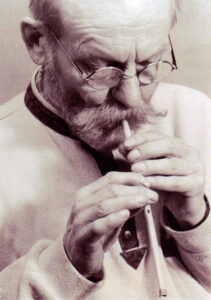
In late 1990’s I met Jarkko Aallonloiske, who taught children to build pipes of willow and reed. I became enchanted of the sound and the visual appearance of his flute covered with birch bark. He told me that he hoped to get an apprentice. I had played piano and violin for many years and I knew basics of music theory. Primitive crafts and diverse use of natural materials were my passion. During those years I was studying to graduate designer of wooden furniture. I felt that I had the perfect background to unify nature, music and crafts.
I took the chance and started to build folky Finnish, Karelian and Ingrian wind instruments at Jarkko’s workshop now and then. We made trips to nature and collected plants, which I learned to refine to simple clarinets and flutes. I heard memories and stories and I joined Jarkko to some events, where he presented the traditional wind instruments.
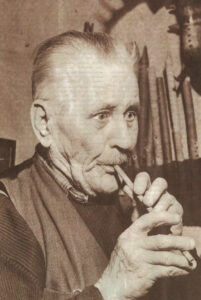
Brass instmentalist and basist Jarkko Aallonloiske had lodged at Teodor ’Teppo’ Repo (originally Feodor Nikitin Safronoff) in autumn 1960 and had got inspired, when the old Ingrian man built old herd instruments. Repo taught the eager musician to harvest birch bark and to build reed pipe, Ingrian horse horn, cow horn truba and various shepherd flutes. Repo had herded sheeps, cows and horses for fifteen summers and had learned instrument building from the herds of the family in the end of 19th century. He had learned early to make music with various instruments and had played French horn in a military band. Repo immigrated to Finland 1918 for work, got married and family. From 1920-tale he started to build and sell traditional wind instruments, which made him known widely. He built instruments for many museums, including The Metropolitan Museum of Art in New York and was awarded honorary membership. Ethno musicologist A. O. Väisänen and other persons with cultural influence became astonished by the originality and skills of Repo and promoted him. Repo performed in radio 1935–1960 and became known as an original folk musician, composer and talented instrument builder of traditional wind instruments. Teppo Repo died in January 1962, a year after he had shared the rare talent to Jarkko.
Jarkko shared the tradition of folk wind instruments industriously for over 50 years. He presented his growing self-built collection of wind instruments in Turku Handicraft Museum and in many fairs 1964–2014. He got a grant for travels to Eastern Finland to find old models of wind instruments to build. In the end of 1980-tale he built and had an exhibition of 80 models which were introducted on Timo Leisiö’s doctoral thesis of Finnish-Karelian pipe- and horn instruments (published in 1983). He kept on building and selling various wind instruments in various historical events; during his active life he has built and sold over 10 000 reedpipes, thousands of simple flutes and Karelian folk clarinets. He taught hundreds of children to build them in camps and had some other adult apprentices, too. Also he built a birch bark trumpet for Jazz-legend Louis Armstrong. Jarkko was awarded an artist pension for good reasons.
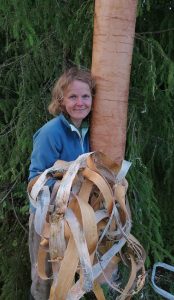
The goal beyond 120 instruments
I was awarded a grant from the Finnish Cultural Foundation for studying traditional wind instruments in 2007. Finally I got the oppurtunity to devote myself to the tradition of folk wind instruments. My project was to build Ingrian herd horns and flutes as well as every instrument presented in the doctoral thesis of Timo Leisiö. The book gives information about size and structure of altogether of 120 models, which have been used in Finland and Karelia between the Neolithic period and 1950’s. I got valuable practical instruction from my master Jarkko Aallonloiske and learned the life story of Teppo Repo.
During the first year we harvested reed on a seahore and took branches from piles in outskirt. I had collected thicker Jarkko taught me to take bark from birches and build diverse wind instruments. I bought a band saw and used it for various purposes, beside japanese saw and iron saw. I used an axe, diverse knives, wood chisels and a spokeshave to shape wood.

At first I built instruments at my master’s workshop, but gradually I got enough experience to build at home, too. For the project I brought home from slaughtery horns of cattle and goats, pig urine bladders and calf stomach and refined them independently. My tanning experiments of urine bladders succeeded well; rubbing of liver oil is a good finish for bladder pipes. I failed to tan a stomach, but I managed to build a bag pipe of a recycled leather in Yrjälä Ermala’s course. Project included vessel flutes of clay; luckily I got to build them at the workshop of a ceramist Raimo Héldan, who had specialised on whistles.
During summer I toured in fairs with Jarkko and I learned to present my own instruments. Playing diverse self-built trumpet- and clarinet instruments was challenging at first, but by practising I learned to shape the details better, which made playing easier. One of the most difficult instruments in the book was the wolf horn, whose tube was supposed to be intact. I hollowed several parts by drilling and joined them together. The wide echo funnel I made from a piece of an old flagpole. Because the model of this instrument was black, I painted the horn with tar and flamed it.
By the autumn 2009 I was sure I’d get everything ready to show for others by the next spring. I’d still build vitrines with my friend, write texts for introduction and market. The space for the exhibition I got in co-operation with The Center of Natural Material KnowHow and ProNatMat -project of Turku University of Applied Sciences. I decided to organize the Pipedays III to introduce my works for the professionals of the field. This gathering of people interested in folky wind instruments hadearlier taken place in Sibelius Academy and in Tampere University.
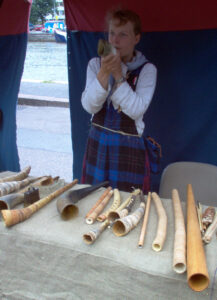
Dedication gives results
Finally I ope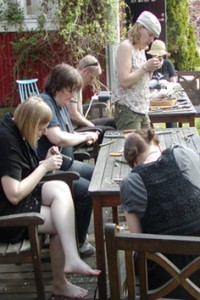 ned the exhibition of almost 130 different wind instruments on the 2nd of May 2010. The nine vitrines were hunged in an old house in the spit of Koroinen, which has a rich history from the 13th century. Traditional instruments of organic material were accepted with enthusiasm. Decoration of surroundings was natural; balloons of urine bladders and serpentine of birch bark strips. I presented the collection playing unique improvised sounds, old runesongs, other folk songs and modern pieces of music.
ned the exhibition of almost 130 different wind instruments on the 2nd of May 2010. The nine vitrines were hunged in an old house in the spit of Koroinen, which has a rich history from the 13th century. Traditional instruments of organic material were accepted with enthusiasm. Decoration of surroundings was natural; balloons of urine bladders and serpentine of birch bark strips. I presented the collection playing unique improvised sounds, old runesongs, other folk songs and modern pieces of music.
Pipedays III gathered some 30 professionals, students and others interested in traditional wind instruments. After I had demonstrated the exhibition we instructed a reedpipe-workshop outside with Jarkko. After lunch, Professor Timo Leisiö lectured about the ancient history of flutes. Instrument builder, musician and teacher Rauno Nieminen told about his project of developing a flute with the best qualities for musician-scientist Kristiina Ilmonen, who had a impressive concert later. After him, librarian Riitta-Liisa Joutsenlahti from Sibelius Academy informed the audience about a deceased folkartist Pentti Mäkelä, who also built flutes and other instruments. After the official program people were invited to see a private person’s remarkable collection of brass instruments. For the evening I had organized a party which began with guided folkdance. After that I sang my own songs and played some music with fresh instruments. The big star of the evening was multi-instrumentalist Kristiina Ilmonen with twenty years of experience with wind instruments. On the next day I taught participants to build more traditional instruments. In the afternoon, sounds of archaic instruments spred joy with the birds.
Media noticed the young woman who appeared to play her pipes and horns beside Jarkko. After building the large collection of traditional wind instruments I was often interviewed by press, radio and TV. Because of popularity I was asked to perform and teach traditional instrument building. The agreed concerts made me to practise intensively. From the beginning it has been fun to use self-built traditional wind instruments for expressive repertoires. The interest for the old pipes and horns have inspired audience to tell memories, test playing and discuss on the needs of these instruments in modern times.
About the Exhibition
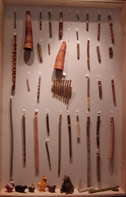


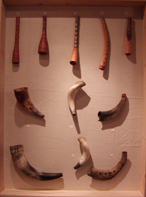

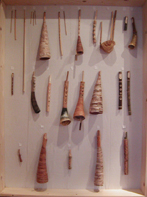
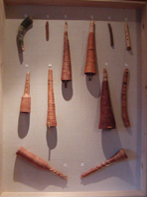

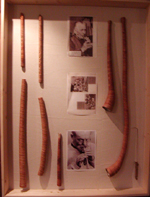
1. The first vitrine includes flutes of diverse materials: willow, birch bark, feather of swan, tin, clay burned into ceramic and clam. Willow whistle is still widely known in Finland even though it’s from Neolithic period. According to the latest scientist news, in Germany has been found 42 000 years old flutes bild of Mammut ivory and bird bone.
2. The trumpets of birch and alderbark, many birch bark covered wooden trumpets and an uncovered hooptrumpet are in the first of the four vitrines.
3. The vitrine contains wooden imitations of the rich people’s metallic trumpets: a trumpet, a tuba and a round trumpet imitating an old Russian military instrument. The straight instrument is called luikka.
4. Smaller wooden trumpets are from Russian Karelia. The horn trumpets of are build of buck, cow and bull horns.
5. The unique mutkaluikku ~ curveluikku is a trumpet made of naturally curved tree branch, After shaping it has been splitted, hollowed and joined with boiled, elastic birchbark.
6. –7. Next two vitrines present three kinds of clarinets. The difference is the reed; it is an inseparable part of the stem in the oldest and the most widespread models from the Iron Age or early Middle Ages. The youngest models from 19th century the reed of juniper or birch bark is fastened with thread. The third model from the 13th century has a special reed, which has been shaped of the topmost half of the hollowed stem. In the first vitrine there are mainly instruments from western Finland and in the other the Karelian models are represented. The vitrine 6. contains also shortlived oboe instruments among others a compressed piece of dandelion tem and a tiny flower of hempnettle.
8. Vitrine presents archaic wind instruments without a tube in a significant role. On the basis of few basic principles there are again several innovative variations. In addition, I present different ways of fastening the end of a birch bark trumpet.
9. The last vitrine presents Ingrian herd instruments: a walking stick flute, a short and long shepherd flute, a cowhorn truba, a horse horn and some copies of the models Jarkko has collected from museums.
The second exhibition of the collection took place in Kuhmo as a part of Sommelo Folk music festival, The third time the instruments were shown to audience in Sarka, The Finnish Museum of Agriculture.
The collection can be rented for museums. I recommend to order the workshops and concerts to let the audience feel and experience the vital originality of these instruments.
Thanks
I’m grateful for Jarkko Aallonloiske and Teppo Repo, in addition to the others who have contributed that the the information of these instruments still exists for sharing.
Thanks go to Sibelius-Academy and Kristiina Ilmonen, Riitta-Liisa and Leena Joutsenlahti for supporting the Pipedays III -event. Thanks to professor emeritus Timo Leisiö and Rauno Nieminen for giving their expertice for the joy and use of everyone. Thanks to Outi Tuomela from Turku University of Applied Sciences and the ProNatMat-project for the exhibition space, marketing and chance to perform and give a workshop in Estonia. Warm thanks to friends who helped me to build the instruments and build the vitrines,
The future –full of possibilities
Traditional wind instruments built of natural materials strengthen connection with nature. Building and playing them is a great and free or very cheap way to spend time, alone and in company, ecologically. Primitive wind instruments provide many ways to express oneself and break the limits. The special sounds create unique atmosphere in bands and genres. Crafts using natural materials and playing pipes and horns by blowing offer many ways for meaningful learning and rehabilitation.
